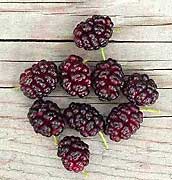


Home
Flowers &
Indoor Plants
Fruits & Nuts
Ornamentals
Vegetables
Special Topics
Resources
Glossary

|
Mulberry Morus nigra (mo-rus nye-gruh) 

Click on thumbnails for larger image. |
 |
What about it? The mulberry is an ornamental as well as a fruit-bearing tree. The trees can grow to 30 feet, and there are many varieties available, including weeping forms. The mulberry looks somewhat like a small blackberry. The fruit is favored by some, and found to be tasteless by others. There are fruitless ornamental species available. The leaves of the white mulberry are fed to silkworms. What is it used for? Jelly, wine and desserts are common uses for the mulberry. Birds are also attracted to the fruits in large numbers; in fact, some people plant mulberries near their cherry trees, since the birds are reputed to enjoy the mulberries even more. Where does it grow? How do we grow it? Mulberries prefer deep, rich soils, but they will tolerate thin gravelly soil, rocky slopes, dry sites and other difficult areas, such as wet or alkaline soils. For this reason, they can be used for erosion control. They produce reliably in frost pockets and exposed areas. Mulberries need full sun, but otherwise, are one of the least "fussy" of the fruit trees. What are its primary problems?The main problem with mulberries is the softness of the fruit. The fruit is easily bruised and squashed, so that transporting and marketing the fresh fruit is very difficult. Harvesting is also difficult because the fruit tends to fall easily from the tree even when still immature. Bacterial leaf spot and cankers caused by fungi can be a concern with mulberries. How do we harvest and store it? Mulberries drop when ripe (much to the disappointment of people who park their cars nearby!) and may be harvested by covering the ground with a sheet or canvas and shaking the tree. They do not all ripen at the same time. Like other soft-fruited crops, mulberries do not store well and are best eaten right away.
© Copyright, Department of Horticulture, Cornell University. |